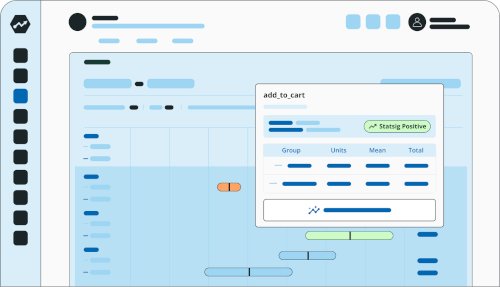
Vibes, as a measure of marketing impact, just don't cut it for B2B companies.
In B2B marketing, experimentation plays a critical role in optimizing strategies for better outcomes. Unfortunately, B2B marketing suffers from numerous additional considerations that make things a bit complicated.
These hurdles stem from the complex nature of B2B transactions, including longer sales cycles and diverse buying committees. Understanding these challenges is crucial for marketers aiming to design effective experiments.
In this article, we'll discuss some ways to start thinking about building experimentation rigor in your B2B marketing initiatives.
Related reading: B2B experimentation examples from the experts.
Key challenges in B2B marketing experimentation
Diverse buying committees
The decision-making process in B2B transactions often involves multiple stakeholders. Each member of the buying committee has distinct priorities, preferences, and influence levels. This diversity makes it difficult to create marketing strategies that are universally appealing.
This is a stark contrast to B2C marketing, wherein efforts are typically targeted towards an individual who is the sole decision-maker.
Tailoring messages to resonate with each B2B stakeholder's specific concerns and roles requires precise segmentation and targeting. Marketers must identify and understand the various personas within these committees to design effective experiments.
Multi-channel buying journeys
B2B buyers typically engage with a brand across several channels before making a purchase decision. This multi-channel journey complicates the measurement of marketing efforts.
Channels include things like:
Blog posts
Email newsletters
Webinars and videos
Technical documentation
Attribution becomes a challenge as marketers try to determine which channels and touchpoints contribute most to conversions. Effective experiments in this context require a robust understanding of the entire buying journey, including the role each channel plays.
Long sales cycles
B2B transactions often feature much lengthier sales cycles than B2C. This duration impacts the evaluation of marketing experiments, as it takes longer to observe the outcomes of changes.
Short-term metrics don't fully capture the long-term effects of a strategy, meaning marketers will need a lot of patience, and a focus on true success indicators.
The pitfalls of proxy metrics
Proxy metrics serve as stand-ins for more significant, often harder-to-measure outcomes in B2B marketing.
"Marketing probably takes something like 60-200 'touches' before someone voluntarily enters your sales funnel, but the 'touches' themselves are vague, somewhat-subliminal, and gravitationally pull someone in your direction."
Now What? on Substack
These metrics usually include email open rates, page views, or download numbers, which marketers use to infer larger trends or outcomes.
These are common in scenarios where direct measurement of success criteria, like revenue impact or customer lifetime value, challenges practicality or immediacy. However, proxy metrics come with limitations. They may not accurately predict long-term success, potentially leading businesses to make misguided strategic decisions.
For instance, a high number of page views on a product page might suggest interest, but without correlating this activity to actual purchases or engagement, the metric offers limited insight into business impact.
This disconnect can lead to overvaluing superficial engagement or underestimating deeper issues with product-market fit.
Examples of misleading proxy metrics include social media "likes" or website traffic spikes. While these may indicate awareness, they don't necessarily translate to buying intent or customer satisfaction.
For example, Statsig's approach to experimentation goes beyond surface-level analytics, focusing on primary metrics directly tied to the specific hypothesis of an experiment. This method emphasizes the importance of selecting metrics that reflect the objectives of a test accurately, such as conversion rates or user engagement levels, rather than relying solely on indirect proxy metrics.
Strategic experimentation framework
Aligning goals with revenue
Aligning marketing goals with revenue outcomes is essential. This approach ensures that every marketing activity has a clear path to contributing to the overall financial success of the business.
For example, Statsig emphasizes the importance of focusing on foundational projects that aim for immediate growth and secure long-term product success.
This perspective encourages marketers to design experiments and strategies that are directly tied to revenue-generating activities rather than merely focusing on engagement or other vanity metrics.
Sidecar no-code A/B testing

Establishing a robust attribution model
A detailed attribution model is crucial in B2B marketing for understanding how different touchpoints contribute to conversions and sales.
Statsig offers insights into creating a robust attribution solution by providing tools that allow for precise measurement of how experimental changes impact key performance indicators.
Setting up an effective attribution model involves identifying and tracking all customer interaction points and using statistical techniques to assign conversion credit accurately. Benefits include better budget allocation towards the most effective marketing channels and strategies, improved ROI, and deeper insights into customer behavior.
Advanced techniques in B2B marketing experimentation
Correlation analysis
Correlation analysis reveals relationships between different market variables. This technique helps B2B marketers understand how changes in one area of their strategy might affect another.
For practical implementation, marketers should identify key metrics that influence business outcomes, such as lead generation rates, and correlate these with marketing activities.
⚠️ Author's Note: Statsig’s platform enables marketers to track these metrics in real-time.
Pipeline acceleration strategies
Accelerating the pipeline means moving leads through the sales cycle faster. Techniques include personalized messaging, targeted content marketing, and strategic use of sales enablement tools.
The impact is two-fold: If done correctly, it not only shortens the sales cycle but also enhances the feedback loop for marketing experiments.
Statsig supports this by allowing marketers to rapidly experiment and iterate across different segments, enabling teams to quickly identify and scale the strategies that most effectively drive pipeline acceleration.
This agility is critical in responding to changing market conditions and optimizing marketing strategies for both immediate and long-term success.
Request a demo




